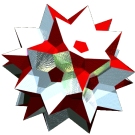|
Acronym
|
sople (old: odop)
|
|
Name
|
square-octagon plus-prism,
octagonal diorthoprism,
compound of 2 sodip
|
|
|
 © ©
|
|
Circumradius
|
sqrt[(3+sqrt(2))/2] = 1.485633
|
Lace city
in approx. ASCII-art
|
x4o x4o
x4o x4x x4x x4o
x4o x4x x4x x4o
x4o x4o
|
x4o x4o
x4o x4o
x4o x4o
x4o x4o
|
x4x x4x
x4x x4x
|
total
compound
|
one sodip
component
|
other sodip
component
|
|
|
Coordinates
|
-
(1+sqrt(2), 1; 1, 1)/2 & permutations in first 2 coordinates, all changes of sign
(corresponds to one sodip)
-
(1, 1; 1+sqrt(2), 1)/2 & permutations in last 2 coordinates, all changes of sign
(corresponds to completely orthogonal sodip)
|
|
General of army
|
sidpith
|
|
Colonel of regiment
|
(subregimental to sidpith)
|
|
Dihedral angles
|
- at {4} between cube and cube: 135°
- at {4} between cube and op: 90°
- at {8} between op and op: 90°
|
|
Confer
|
- uniform relative:
-
sidpith
iquipadah
- compound-component:
-
sodip
|
External
links
|

|
As abstract polytope sople is isomorphic to sistople, thereby replacing
octagons by octagrams, resp. op by stop,
resp. sodip by sistodip.
All cubes in here clearly are used as square prisms only.
This simply is derived from the individual components, the sodips.
But now the square symmetry of the one sodip cancels down the full eightfold one of the other
in either of the two orthogonal subspaces. Therefore we get now "lacing cubes"
(which are just underneath a single octagon) and to be distinguished "para cubes"
(which are parallel to the ops).
And thence the lacing squares of the two groups as well are to be distinguished.
And therefore the lacing edges of those lacing squares as well have to be distinguished.
Thus the octagons would get alternating sides out of the latter ones.
And likewise the squares of the ops too will be alternating.
Incidence matrix
64 | 2 1 1 | 1 2 2 1 | 1 1 2 || 1
---+----------+------------+-------++--
2 | 64 * * | 1 1 1 0 | 1 1 1 || 1
2 | * 32 * | 0 2 0 1 | 1 0 2 || 1
2 | * * 32 | 0 0 2 1 | 0 1 2 || 1
---+----------+------------+-------++--
4 | 4 0 0 | 16 * * * | 1 1 0 || 1
4 | 2 2 0 | * 32 * * | 1 0 1 || 1
4 | 2 0 2 | * * 32 * | 0 1 1 || 1
8 | 0 4 4 | * * * 8 | 0 0 2 || 1
---+----------+------------+-------++--
8 | 8 4 0 | 2 4 0 0 | 8 * * || 1 para cube
8 | 8 0 4 | 2 0 4 0 | * 8 * || 1 lacing cube
16 | 8 8 8 | 0 4 4 2 | * * 8 || 1 op
---+----------+------------+-------++--
32 | 32 16 16 | 8 16 16 4 | 4 4 4 || 2 sodip
©
